#10-4-19
Text

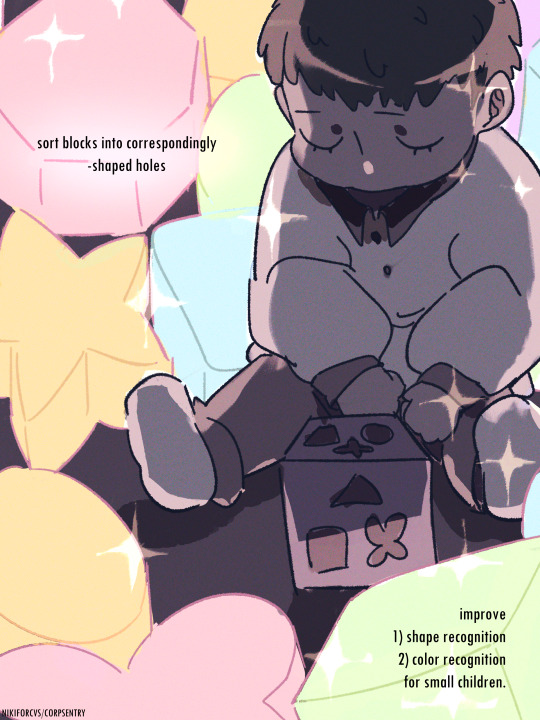

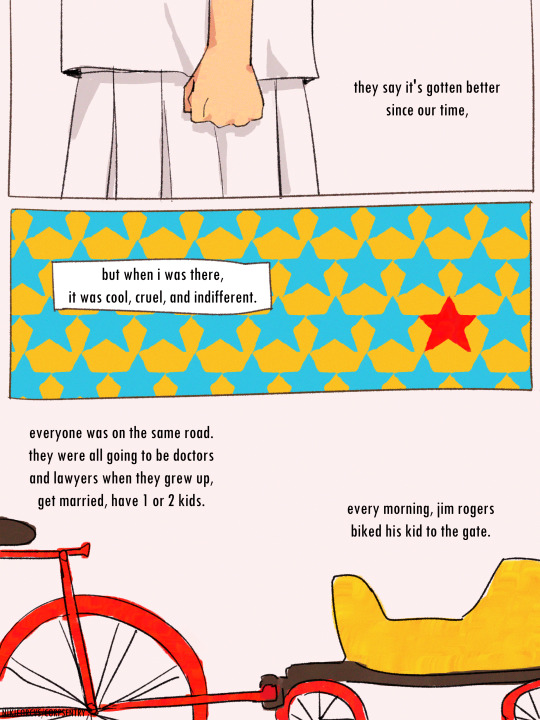
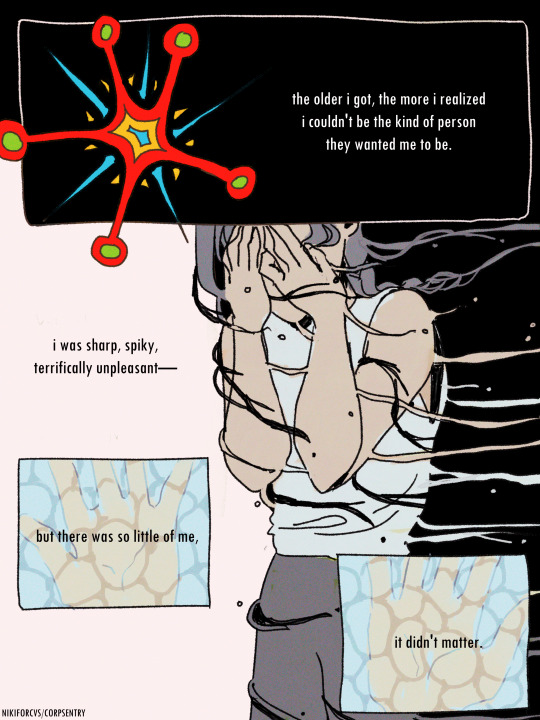
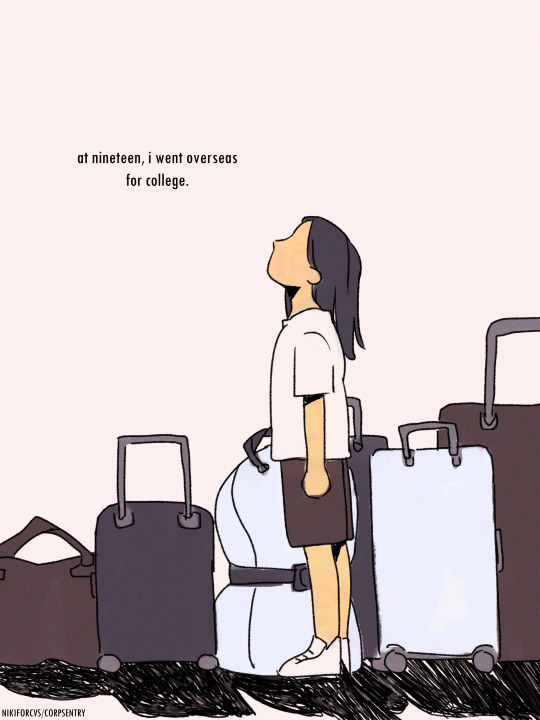
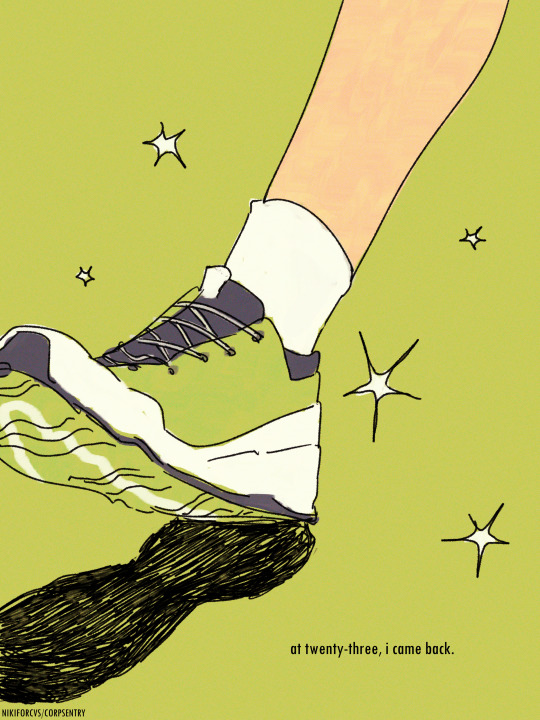



a glass sun 1/2
#my art#my stuff#this is really fucking long so im gonna have to break it up into multiple reblogs#(howling) WAUGHHHHHHH#i love aishang by xiaoshiguniang#i love to implicate my alma mater in my art about being gay in the shittiest most conservative corner of singaporean society#by some terrible trick of fate i ended up in the conservative chinese christian cishet circuit from primary school to end of hs#obviously i am not most of these things but there i was. Depressed#and there i was after that at Liberal Arts College. the 4 years i spent there were a clusterfuck#but like a good and outrageous and lively clusterfuck#and i graduated in may this year and when i came back it was for the first time in 10 months. it was like. what da hell#like i love being here in specific ways but there is also the pain of being seen as something you're not constantly#can i blame them? i ask myself this every day. for most of my ex classmates and relatives i Am the only not cis person they know#idk my lottery number was bad this corner of society really is that bad#and so its like. idk dawg anyway i aint offering solutions but u get it like it fucks with your head to be misgendered either which way 24/#but to leave them behind would be to leave the only people who knew me for the first 19 years behind. and thats a lot of my life#i am 23!!!!!! ough#anyway. whatever. if u liked it i have a ko-fi#reblogos appreciated
505 notes
·
View notes
Text
cabin headcanons masterlist



a/n: these are all my personal headcanons. i will be making ones for more minor gods.
cabin 1- zeus ⚡️
cabin 3- poseidon 🌊
cabin 4- demeter 🪴
cabin 5- ares ⚔️
cabin 6- athena 🧠
cabin 7- apollo ☀️
cabin 8- artemis 🌙
cabin 9- hephaestus 🛠️
cabin 10- aphrodite 💗
cabin 11- hermes ⚕️
cabin 12- dionysus 🍷
cabin 13- hades 💀
cabin 14- iris 🌈
cabin 15- hypnos 💤
cabin 16- nemesis ⚖️
cabin 17- nike 🏆
cabin 18- hebe 🍶
cabin 19- tyche 🎰
cabin 20- hecate 🪄
cabin 21- hestia 🔥
cabin 22- thanatos 🪦
cabin 23- morpheus 🛌
cabin 24- melinoe 👻
cabin 25- persephone 🌸
cabin 26- eros 💘
cabin 27- nyx 🌌
#percy jackson and the olympians#heroes of olympus#pjo#hoo#pjo hoo toa#pjo fandom#hoo fandom#pjo series#hoo series#pjo cabins#cabin 1#cabin 3#cabin 4#cabin 5#cabin 6#cabin 7#cabin 9#cabin 10#cabin 11#cabin 12#cabin 13#cabin 14#cabin 15#cabin 16#cabin 17#cabin 18#cabin 19#cabin 20#cabin 21#cabin 22
191 notes
·
View notes
Text
The danger is clear and present: COVID isn’t merely a respiratory illness; it’s a multi-dimensional threat impacting brain function, attacking almost all of the body’s organs, producing elevated risks of all kinds, and weakening our ability to fight off other diseases. Reinfections are thought to produce cumulative risks, and Long COVID is on the rise. Unfortunately, Long COVID is now being considered a long-term chronic illness — something many people will never fully recover from.
Dr. Phillip Alvelda, a former program manager in DARPA’s Biological Technologies Office that pioneered the synthetic biology industry and the development of mRNA vaccine technology, is the founder of Medio Labs, a COVID diagnostic testing company. He has stepped forward as a strong critic of government COVID management, accusing health agencies of inadequacy and even deception. Alvelda is pushing for accountability and immediate action to tackle Long COVID and fend off future pandemics with stronger public health strategies.
Contrary to public belief, he warns, COVID is not like the flu. New variants evolve much faster, making annual shots inadequate. He believes that if things continue as they are, with new COVID variants emerging and reinfections happening rapidly, the majority of Americans may eventually grapple with some form of Long COVID.
Let’s repeat that: At the current rate of infection, most Americans may get Long COVID.
[...]
LP: A recent JAMA study found that US adults with Long COVID are more prone to depression and anxiety – and they’re struggling to afford treatment. Given the virus’s impact on the brain, I guess the link to mental health issues isn’t surprising.
PA: There are all kinds of weird things going on that could be related to COVID’s cognitive effects. I’ll give you an example. We’ve noticed since the start of the pandemic that accidents are increasing. A report published by TRIP, a transportation research nonprofit, found that traffic fatalities in California increased by 22% from 2019 to 2022. They also found the likelihood of being killed in a traffic crash increased by 28% over that period. Other data, like studies from the National Highway Traffic Safety Administration, came to similar conclusions, reporting that traffic fatalities hit a 16-year high across the country in 2021. The TRIP report also looked at traffic fatalities on a national level and found that traffic fatalities increased by 19%.
LP: What role might COVID play?
PA: Research points to the various ways COVID attacks the brain. Some people who have been infected have suffered motor control damage, and that could be a factor in car crashes. News is beginning to emerge about other ways COVID impacts driving. For example, in Ireland, a driver’s COVID-related brain fog was linked to a crash that killed an elderly couple.
Damage from COVID could be affecting people who are flying our planes, too. We’ve had pilots that had to quit because they couldn’t control the airplanes anymore. We know that medical events among U.S. military pilots were shown to have risen over 1,700% from 2019 to 2022, which the Pentagon attributes to the virus.
[...]
LP: You’ve criticized the track record of the CDC and the WHO – particularly their stubborn denial that COVID is airborne.
PA: They knew the dangers of airborne transmission but refused to admit it for too long. They were warned repeatedly by scientists who studied aerosols. They instituted protections for themselves and for their kids against airborne transmission, but they didn’t tell the rest of us to do that.
[...]
LP: How would you grade Biden on how he’s handled the pandemic?
PA: I’d give him an F. In some ways, he fails worse than Trump because more people have actually died from COVID on his watch than on Trump’s, though blame has to be shared with Republican governors and legislators who picked ideological fights opposing things like responsible masking, testing, vaccination, and ventilation improvements for partisan reasons. Biden’s administration has continued to promote the false idea that the vaccine is all that is needed, perpetuating the notion that the pandemic is over and you don’t need to do anything about it. Biden stopped the funding for surveillance and he stopped the funding for renewing vaccine advancement research. Trump allowed 400,000 people to die unnecessarily. The Biden administration policies have allowed more than 800,000 to 900,000 and counting.
[...]
LP: The situation with bird flu is certainly getting more concerning with the CDC confirming that a third person in the U.S. has tested positive after being exposed to infected cows.
PA: Unfortunately, we’re repeating many of the same mistakes because we now know that the bird flu has made the jump to several species. The most important one now, of course, is the dairy cows. The dairy farmers have been refusing to let the government come in and inspect and test the cows. A team from Ohio State tested milk from a supermarket and found that 50% of the milk they tested was positive for bird flu viral particles.
[...]
PA: There’s a serious risk now in allowing the virus to freely evolve within the cow population. Each cow acts as a breeding ground for countless genetic mutations, potentially leading to strains capable of jumping to other species. If any of those countless genetic experiments within each cow prove successful in developing a strain transmissible to humans, we could face another pandemic – only this one could have a 58% death rate. Did you see the movie “Contagion?” It was remarkably accurate in its apocalyptic nature. And that virus only had a 20% death rate. If the bird flu makes the jump to human-to-human transition with even half of its current lethality, that would be disastrous.
#sars cov 2#covid 19#h5n1#bird flu#articles#long covid is def a global issue not just for those in the us and most countries aren't doing much better#regardless of how much lower the mortality rate for h5n1 may or may not become if/when it becomes transmissible between humans#having bird flu infect a population the majority of whose immune system has been decimated by sars2#to the point where the average person seems to have a hard time fighting off the common cold etc...#(see the stats of whooping cough/pertussis and how they're off the CHARTS this yr in the uk and aus compared to previous yrs?#in qld average no of cases was 242 over prev 4 yrs - there have been /3783/ diagnosed as of june 9 this yr and that's just in one state.#there's a severe shortage of meds for kids in aus bc of the demand and some parents visit +10 pharmacies w/o any luck)#well.#let's just say that i miss the days when ph orgs etc adhered to the precautionary principle and were criticised for 'overreacting'#bc nothing overly terrible happened in the end (often thanks to their so-called 'overreaction')#now to simply acknowledge the reality of an obviously worsening situation is to be accused of 'fearmongering'#🤷♂️#also putting long covid and bird flu aside for a sec:#one of the wildest things that everyone seems to overlook that conor browne and others on twt have been saying for yrs#is that the effects of the covid pandemic extend far beyond the direct impacts of being infected by the virus itself#we know sars2 rips apart immune system+attacks organs. that in effect makes one more susceptible to other viruses/bacterial infections etc#that in turn creates increased demand for healthcare services for all kinds of carers and medications#modern medicine and technology allows us to provide often effective and necessary treatment for all kinds of ailments#but what if there's not enough to go around? what happens when the demand is so high that it can't be provided fast enough -- or at all?#(that's assuming you can even afford it)#what happens when doctors and nurses and other healthcare workers keep quitting due to burnout from increased patients and/or illness#because they themselves do not live in a separate reality and are not any more sheltered from the effects of constant infection/reinfection#of sars2 and increased susceptibility to other illnesses/diseases than the rest of the world?#this is the 'new normal' that's being cultivated (the effects of which are already blatantly obvious if you're paying attention)#and importantly: it. doesn't. have. to. be. this. way.
279 notes
·
View notes
Text
ʚ The Divine Cabin Assigner! ɞ - CLOSED (for now)

Hello! Welcome to my cabin assigner! I’m Bea, your friendly neighbor Cabin 10 counselor.
Are you unsure of your godly parent? Do those online tests just not feel right?
Or maybe you already know your parent, but want to see if I can guess it? Well, this is the place for you!
જ⁀➴ What to comment
- You find yourself stranded in a dense forest with nothing but your wits. What are you doing first?
- After hiking through the forest for seemingly hours, you see something out of the corner of your eye. What is it?
- Finally reaching a clearing in the forest, you spot a few drachma (currency of the gods) under a bush. What are you doing with it?
And of course; describe yourself a bit! Your defining traits, your fashion sense, favorite activities, romantic preference, pronouns, name, etc! If you know your MBTI type, comment that as well. Anything about you will help me better guess your cabin. ♡︎

See you in the comments!
~ bea ୨ৎ
#godly parents#percy jackson#percy jackon and the olympians#pjo series#pjo#pjo tv show#pjo fandom#pjo disney+#pjo spoilers#aphrodite#cabin 10#cabin 11#cabin 17#cabin 5#cabin 20#cabin 4#cabin 3#cabin 12#cabin 15#cabin 13#cabin 14#cabin 16#cabin 18#cabin 19#cabin 6#cabin 7#cabin 9
176 notes
·
View notes
Text
thinking about canon bisexual angela montenegro and how i saw her kissing a girl on tv in my moms room when i was supposed to be asleep in 2009 and felt a sort of affinity for her i couldn't quite explain. thinking about how she made a version of me who was so young they thought love was just something made up for the movies feel just for a moment, like i could be a real person and not a doll.
#saw this when i was 4 btw . realized i liked girls when i was 10#im 19 now and a happy thriving lesbian . my first crush being angela montenegro was really it for me now im obsessed w art girls#bones tv#bones#bones on fox#angela montenegro#bisexual angela montenegro
67 notes
·
View notes
Text
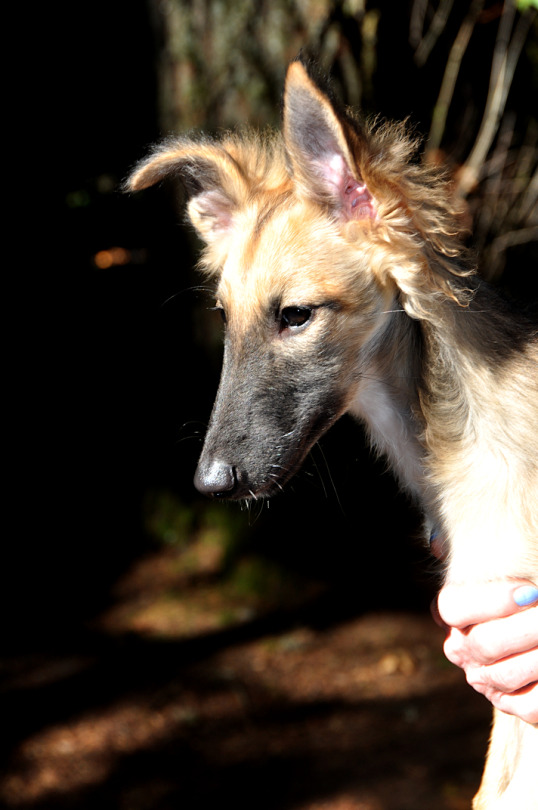

Adzuki faces.

Profiles in concentration.
Silken Windhound, 4 months
175 notes
·
View notes
Text
Beef:I have no imagination, ok?! I need things to be very realistic
106 notes
·
View notes
Note
Surely!
WIP Wednesday 4/10/24 (Closed) | Surely
Andrew lets him go but not as violently as he usually did when in the throes of panic, and Andrew does not let him go far. He drops the knife in his hand and looks at Neil with wide panicked eyes that make Neil want to strangle everyone who ever called Andrew emotionless. He holds Neil at arms length but frantically starts to pat his face, his hands and-
Oh.
"I made it out of Baltimore Andrew." Neil says and watches as Andrew blinks. "My face and hands are healed. Nathan didn't get my legs."
<- PREV | FIRST | NEXT ->
#FIC: Surely#AFTG#AFTG Fic#Andrew Minyard#Neil Josten#Mary Hatford#Andreil#Surely - Roy Rogers - 19#4-10-24 WIP Wednesday#WIP Wednesday Ask Game#16
23 notes
·
View notes
Text

#Richard Tuttle#Black Light#10#2021#paper#watercolor#tape#glue#graphite#and t-pins#24 x 19 1/2 x 6 1/4 inches#(61 x 49.5 x 15.9 cm)
22 notes
·
View notes
Text
sometimes its so crazy to realize that there's actually a lot of things i like. that i thought i didn't like because i was a depressed teenager. i love being outside! i love swimming! i love talking to people! even strangers sometimes! i love getting dressed in fun outfits and doing makeup! i love reading and going to art museums! i just thought i was doomed forever to a life of complete and total apathy and void! and now look at me! still a little shaky but i'm doing it!!!!!
#reaching back thru the spacetime continuum to grab 15 year old bunny and shake him by the shoulders a little bit and go hey!!!#it's not ALWAYS gonna be like this!!!#one day you're gonna be 23 and it'll still be like this sometimes!!!#sometimes you'll still wake up and feel it but it won't be all the time!!!!!!#you're gonna have friends who know you and see you even the ugly parts of you#and they're still gonna love you anyways!!!!! it's not over yet i promise!!!!!!#and then one day when i'm 34 i'm sure i'll think the same thing about me now#but until then! it's me and myself when i was 22 and 21 and 20 and 19 and 18 and 17 and 16 and 15#and 14 and 13 and 12 and 11 and 10 and 9 and 8 and 7 and 6 and 5 and 4 and 3 and 2 and 1
13 notes
·
View notes
Text
Alright I have a lot of ocs for Percy Jackson, but I don’t have a lot of powers for them. Like, the most interesting power I have rn is an Apollo kid who can inflict plague and sickness on other people. All my other characters? Lame! So, give me suggestions on powers for any cabin that aren’t just “Oh, a son of Poseidon controls water”.
Thanks :)
#percy jackson#percy jackon and the olympians#cabins#cabin 1#cabin 2#cabin 3#cabin 4#cabin 5#cabin 6#cabin 7#cabin 8#cabin 9#cabin 10#cabin 11#cabin 12#cabin 13#cabin 14#cabin 15#cabin 16#cabin 17#cabin 18#cabin 19#cabin 20#demigods#power#magic
14 notes
·
View notes
Text
you ever think about how pretty much the only reason we use base10 is because we have 10 fingers and if everyone had 6 fingers on each hand we'd use base12 and never even think a thing of it and also math would be pretty much better in every way?
#i think for this september's existential crisis i'm gonna become a base12 truther#and bc i know everyone on this website is math illiterate so to clarify:#the way base12 works is that we have a few extra digits between 9 and 10#so to count we go:#0 1 2 3 4 5 6 7 8 9 X Y#so X = 10 and Y = 11#then '10' = 12#so the next step of counting goes:#10 11 12 13 14 15 16 17 18 19 1X 1Y#(i know this looks insane to you but the only reason for that is because you are used to base 10 i promise this makes sense#if you throw away everything you know and come at it with fresh eyes)#so anyways in this case '11' = 13. '19' = 21. 1X = 22. 1Y = 23#and '20' = 24#bc the tens column is not the tens column it's actually the twelves column#so each [number] in the second column does not mean 'add [this many] 10s to this' it means 'add [this many] 12s to this'#and this would not be tricky at higher numbers bc in base12 twelve is not counted as 'ten and two' it's just its own thing#in fact it would be harder to multiply by tens bc 10 would be the equivalent of like. 8 here.#it's not its own thing (ten) it's actually 'twelve minus two'#to count by tens goes '0 Y 18 26 34 42 50' and '50' is of course 10x6 in this case so it equals 60 in base10#not hard#there's a pattern to it.#but it's not as easy as counting by 12s#anyways we already have base12 systems and i like them they are very easy to divide#it's only harder than base10 bc arabic numerals are base10 so it's harder to depict base12 logically in a base10 system#hours are base 12. inches to feet are base 12#anyways this post is legally classified as scifi and/or speculative fiction#or. fuck. it's not even fictional#this is how math would work in a different system#sci-nonfi#speculative nonfiction
7 notes
·
View notes
Text
Spankofski brothers photo album






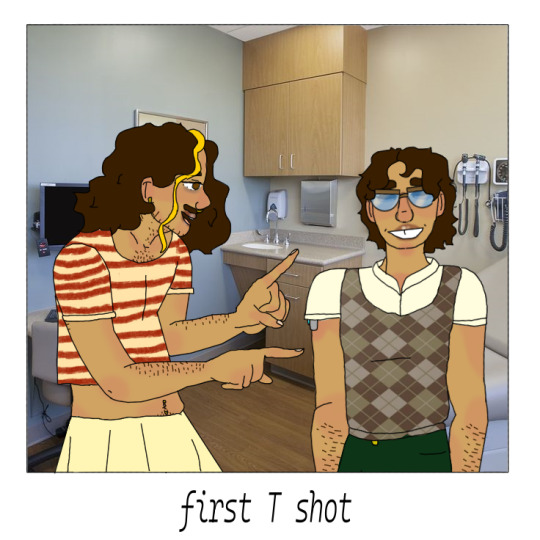
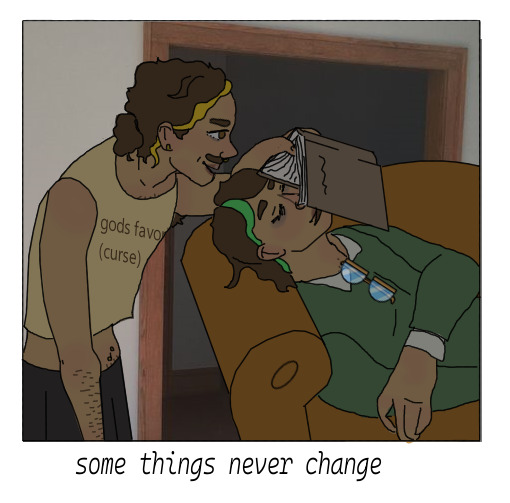

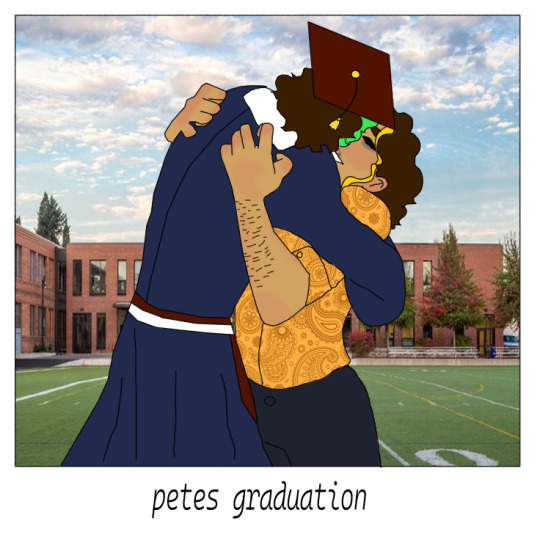
#digital art#digital drawing#digital fanart#digital illustration#fanart#timeline#pete spankoffski#stephanie lauter#steph lauter#peter spankoffski#ted spankoffski#trans peter spankoffski#ages are ...#2 and 19#4 and 21#5 and 22#6 and 23#7 and 24#8 and 25#10 and 27#14 and 31#18 and 35#this took me way too long to make#hachetfield#for some reason this isent showing up in my hachetfeiod tag#tumblr is a functional websote
44 notes
·
View notes
Text
ever since I was little I never gave a fuck if anyone else liked me, I just wanted to like me and eventually I did for a little while but then I forgot how
#2012 and 2016 were my 2 best years probably#12/13 & 16/17 yro me slayed too hard I fear#1/2/3/4/5/6/7/8/9/10/11/14/15/18/19/20/21/22/23/24/25 flopped#though 20 was ok ily lockdown
12 notes
·
View notes
Text
Cancelled Missions: NASA's October 1977 Space Shuttle Flight Itinerary
"Soon after President Richard Nixon gave his blessing to the Space Shuttle Program on January 5, 1972, NASA scheduled its first orbital flight for 1977, then for March 1978. By early 1975, the date had slipped to March 1979. Funding shortfalls were to blame, as were the daunting engineering challenges of developing the world's first reusable orbital spaceship based on 1970s technology. The schedule slip was actually worse than NASA let on: as early as January 32, 1975, an internal NASA document (marked 'sensitive') gave a '90% probability date' for the first Shuttle launch of December 1979.
In October 1977, Chester Lee, director of Space Transportation System (STS) Operations at NASA Headquarters, distributed the first edition of the STS Flight Assignment Baseline, a launch schedule and payload manifest for the first 16 operational Shuttle missions. The document was in keeping with NASA's stated philosophy that reusable Shuttle Orbiters would fly on-time and often, like a fleet of cargo airplanes. The STS Utilization and Operations Office at NASA's Johnson Space Center (JSC) in Houston had prepared the document, which was meant to be revised quarterly as new customers chose the Space Shuttle as their cheap and reliable ride to space.
The JSC planners assumed that six Orbital Flight Test (OFT) missions would precede the first operational Shuttle flight. The OFT flights would see two-man crews (Commander and Pilot) put Orbiter Vehicle 102 (OV-102) through its paces in low-Earth orbit. The planners did not include the OFT schedule in their document, but the May 30, 1980 launch date for their first operational Shuttle mission suggests that they based their flight schedule on the March 1979 first OFT launch date.
Thirteen of the 16 operational flights would use OV-102 and three would use OV-101. NASA would christen OV-102 Columbia in February 1979, shortly before it rolled out of the Rockwell International plant in Palmdale, California.
As for OV-101, its name was changed from Constitution to Enterprise in mid-1976 at the insistence of Star Trek fans. Enterprise flew in Approach and Landing Test (ALT) flights at Edwards Air Force Base in California beginning on February 15, 1977. ALT flights, which saw the Orbiter carried by and dropped from a modified 747, ended soon after the NASA JSC planners released their document.
The first operational Space Shuttle mission, Flight 7 (May 30 - June 3, 1980), would see Columbia climb to a 225-nautical-mile (n-mi) orbit inclined 28.5° relative to Earth's equator (unless otherwise stated, all orbits are inclined at 28.5°, the latitude of Kennedy Space Center in Florida). The delta-winged Orbiter would carry a three-person crew in its two-deck crew compartment and the bus-sized Long Duration Exposure Facility (LDEF) in its 15-foot-wide, 60-foot-long payload bay.
Columbia would also carry a 'payload of opportunity' - that is, an unspecified payload. The presence of a payload of opportunity meant that the flight had available excess payload weight capacity. Payload mass up would total 27,925 pounds. Payload mass down after the Remote Manipulator System (RMS) arm hoisted LDEF out of Columbia's payload bay and released it into orbit would total 9080 pounds.

A page from the STS Flight Assignment Baseline document of October 1977 shows payloads and other features of the first five operational Space Shuttle missions plus Flight 12/Flight 12 Alternate
During Flight 8 (July 1-3, 1980), Columbia would orbit 160 n mi above the Earth. Three astronauts would release two satellites and their solid-propellant rocket stages: Tracking and Data Relay Satellite-A (TDRS-A) with a two-stage Interim Upper Stage (IUS) and the Satellite Business Systems-A (SBS-A) commercial communications satellite on a Spinning Solid Upper Stage-Delta-class (SSUS-D).
Prior to release, the crew would spin the SBS-A satellite about its long axis on a turntable to create gyroscopic stability and raise TDRS-A on a tilt-table. After release, their respective solid-propellant stages would propel them to their assigned slots in geostationary orbit (GEO), 19,323 n mi above the equator. Payload mass up would total 51,243 pounds; mass down, 8912 pounds, most of which would comprise reusable restraint and deployment hardware for the satellites.
The TDRS system, which would include three operational satellites and an orbiting spare, was meant to trim costs and improve communications coverage by replacing most of the ground-based Manned Space Flight Network (MSFN). Previous U.S. piloted missions had relied on MSFN ground stations to relay communications to and from the Mission Control Center (MCC) in Houston. Because spacecraft in low-Earth orbit could remain in range of a given ground station for only a few minutes at a time, astronauts were frequently out of contact with the MCC.
On Flight 9 (August 1-6, 1980), Columbia would climb to a 160-n-mi orbit. Three astronauts would deploy GOES-D, a National Oceanic and Atmospheric Administration (NOAA) weather satellite, and Anik-C/1, a Canadian communications satellite. Before release, the crew would raise the NOAA satellite and its SSUS-Atlas-class (SSUS-A) rocket stage on the tilt-table and spin up the Anik-C/1-SSUS-D combination on the turntable. In addition to the two named satellites, NASA JSC planners reckoned that Columbia could carry a 14,000-pound payload of opportunity. Payload mass up would total 36,017 pounds; mass down, 21,116 pounds.
Following Flight 9, NASA would withdraw Columbia from service for 12 weeks to permit conversion from OFT configuration to operational configuration. The JSC planners explained that the conversion would be deferred until after Flight 9 to ensure an on-time first operational flight and to save time by combining it with Columbia's preparations for the first Spacelab mission on Flight 11. The switch from OFT to operational configuration would entail removal of Development Flight Instrumentation (sensors for monitoring Orbiter systems and performance); replacement of Commander and Pilot ejection seats on the crew compartment upper deck (the flight deck) with fixed seats; power system upgrades; and installation of an airlock on the crew compartment lower deck (the mid-deck).
Flight 10 (November 14-16, 1980) would be a near-copy of Flight 8. A three-person Columbia crew would deploy TDRS-B/IUS and SBS-B/SSUS-D into a 160-n-mi-high orbit. The rocket stages would then boost the satellites to GEO. Cargo mass up would total 53,744 pounds; mass down, 11,443 pounds.
Flight 11 (December 18-25, 1980) would see the orbital debut of Spacelab. Columbia would orbit Earth 160 n mi high at 57° of inclination. NASA and the multinational European Space Research Organization (ESRO) agreed in August 1973 that Europe should develop and manufacture Spacelab pressurized modules and unpressurized pallets for use in the Space Shuttle Program. Initially dubbed the 'sortie lab,' Spacelab would operate only in the Orbiter payload bay; it was not intended as an independent space station, though many hoped that it would help to demonstrate that an Earth-orbiting station could be useful.
ESRO merged with the European Launcher Development Organization in 1975 to form the European Space Agency (ESA). Columbia's five-person crew for Flight 11 would probably include scientists and at least one astronaut from an ESA member country.
Flight 12 (January 30 - February 1, 1981), a near-copy of Flights 8 and 10, would see Columbia's three-person crew deploy TDRS-C/IUS and Anik-C/2/SSUS-D into 160-n-mi-high orbit. Payload mass up would total 53,744 pounds; mass down, 11,443 pounds.
JSC planners inserted an optional 'Flight 12 Alternate' (January 30 - February 4, 1981) into their schedule which, if flown, would replace Flight 12. Columbia would orbit 160 n mi above the Earth. Its three-person crew would deploy Anik-C/2 on a SSUS-D stage. The mission's main purpose, however, would be to create a backup launch opportunity for an Intelsat V-class satellite already scheduled for launch on a U.S. Atlas-Centaur or European Ariane I rocket. An SSUS-A stage would boost the Intelsat V from Shuttle orbit to GEO.
NASA JSC assumed that, besides the satellites, stages, and their support hardware, Columbia would for Flight 12 Alternate tote an attached payload of opportunity that would need to operate in space for five days to provide useful data (hence the mission's planned duration). Payload mass up would total 37,067 pounds; mass down, 17,347 pounds.

Space Shuttle Flights 13 through 18 would include the first orbital mission of the OV-101 Enterprise (Flight 17), during which astronauts would retrieve the LDEF payload deployed during Flight 7.
Flight 13 (March 3-8, 1981) would see three astronauts on board Columbia release NOAA's GOES-E satellite attached to an SSUS-D stage into a 160-n-mi-high orbit. OV-102 would have room for two payloads of opportunity: one attached at the front of the payload bay and one deployed from a turntable aft of the GOES-E/SSUS-D combination. Payload mass up would total 38,549 pounds; mass down, 23,647 pounds.
Flight 14 would last 12 days, making it the longest described in the STS Flight Assignment Baseline document. Scheduled for launch on April 7, 1981, it would carry a 'train' of four unpressurized Spacelab experiment pallets and an 'Igloo,' a small pressurized compartment for pallet support equipment. The Igloo, though pressurized, would not be accessible to the five-person crew. OV-102 would orbit 225 n mi high at an inclination of 57°. Mass up would total 31,833 pounds; mass down, 28,450 pounds.
Flight 15 (May 13-15, 1981) would be a near-copy of Flights 8, 10, and 12. OV-102 would transport to orbit a payload totaling 53,744 pounds; payload mass down would total 11,443 pounds. The JSC planners noted the possibility that none of the potential payloads for Flight 15 — TDRS-D and SBS-C or Anik-C/3 — would need to be launched as early as May 1981. TDRS-D was meant as an orbiting spare; if the first three TDRS operated as planned, its launch could be postponed. Likewise, SBS-C and Anik-C/3 were each a backup for the previously launched satellites in their series.
Flight 16 (June 16-23, 1981) would be a five-person Spacelab pressurized module flight aboard OV-102 in 160-n-mi-high orbit. Payloads of opportunity totaling about 18,000 pounds might accompany the Spacelab module; for planning purposes, a satellite and SSUS-D on a turntable behind the module was assumed. Payload mass up would total 35,676 pounds; mass down, 27,995 pounds.
Flight 17, scheduled for July 16-20, 1981, would see the space debut of Enterprise and the retrieval of the LDEF released during Flight 7. OV-101 would climb to a roughly 200-n-mi-high orbit (LDEF's altitude after 13.5 months of orbital decay would determine the mission's precise altitude).
Before rendezvous with LDEF, Flight 17's three-man crew would release an Intelsat V/SSUS-A and a satellite payload of opportunity. After the satellites were sent on their way, the astronauts would pilot Enterprise to a rendezvous with LDEF, snare it with the RMS, and secure it in the payload bay. Mass up would total 26,564 pounds; mass down, 26,369 pounds.
For Flight 18 (July 29-August 5, 1981), Columbia would carry to a 160-n-mi-high orbit a Spacelab pallet dedicated to materials processing in the vacuum and microgravity of space. The three-person flight might also include the first acknowledged Department of Defense (DOD) payload of the Space Shuttle Program, a U.S. Air Force pallet designated STP-P80-1. JSC called the payload 'Planned' rather than 'Firm' and noted somewhat cryptically that it was the Teal Ruby experiment 'accommodated from OFT [Orbital Flight Test].'
The presence of the Earth-directed Teal Ruby sensor payload would account for Flight 18's planned 57° orbital inclination, which would take it over most of Earth's densely populated areas. Payload mass up might total 32,548 pounds; mass down, 23,827 pounds.

Space Shuttle Flights 20 through 23 would include the first mission to make use of an OMS kit to increase its orbital altitude (Flight 21), the first European Space Agency-sponsored Spacelab mission (Flight 22), and the launch of the Jupiter Orbiter and Probe spacecraft (Flight 23)
Flight 19 (September 2-9, 1981) would see five Spacelab experiment pallets fill Columbia's payload bay. Five astronauts would operate the experiments, which would emphasize physics and astronomy. The Orbiter would circle Earth in a 216-n-mi-high orbit. Payload mass up would total 29,214 pounds; mass down, 27,522 pounds.
Flight 20 (September 30-October 6, 1981), the second Enterprise mission, would see five astronauts conduct life science and astronomy experiments in a 216-n-mi-high orbit using a Spacelab pressurized module and an unpressurized pallet. JSC planners acknowledged that the mission's down payload mass (34,248 pounds) might be 'excessive,' but noted that their estimate was 'based on preliminary payload data.' Mass up would total 37,065 pounds.
On Flight 21, scheduled for launch on October 14, 1981, Columbia would carry the first Orbital Maneuvering System (OMS) Kit at the aft end of its payload bay. The OMS Kit would carry enough supplemental propellants for the Orbiter's twin rear-mounted OMS engines to perform a velocity change of 500 feet per second. This would enable OV-102 to rendezvous with and retrieve the Solar Maximum Mission (SMM) satellite in a 300-n-mi-high orbit.
Three astronauts would fly the five-day mission, which would attain the highest orbital altitude of any flight in the STS Flight Assignment Baseline document. JSC planners noted that the Multi-mission Modular Spacecraft (MMS) support hardware meant to carry SMM back to Earth could also transport an MMS-type satellite into orbit. Payload mass up would total 37,145 pounds; mass down, 23,433 pounds.
On Flight 22 (November 25 - December 2, 1981), Enterprise might carry an ESA-sponsored Spacelab mission with a five-person crew, a pressurized lab module, and a pallet to a 155-to-177-n-mi orbit inclined at 57°. Payload mass up might total 34,031 pounds; mass down, 32,339 pounds.
During Flight 23 (January 5-6, 1982), the last described in the STS Flight Assignment Baseline document, three astronauts would deploy into a 150-to-160-n-mi-high orbit the Jupiter Orbiter and Probe (JOP) spacecraft on a stack of three IUSs. President Jimmy Carter had requested new-start funds for JOP in his Fiscal Year 1978 NASA budget, which had taken effect on October 1, 1977. Because JOP was so new when they prepared their document, JSC planners declined to estimate up/down payload masses.
Flight 23 formed an anchor point for the Shuttle schedule because JOP had a launch window dictated by the movements of the planets. If the automated explorer did not leave for Jupiter between January 2 and 12, 1982, it would mean a 13-month delay while Earth and Jupiter moved into position for another launch attempt.
Almost nothing in the October 1977 STS Flight Assignment Baseline document occurred as planned. It was not even updated quarterly; no update had been issued as of mid-November 1978, by which time the target launch dates for the first Space Shuttle orbital mission and the first operational Shuttle flight had slipped officially to September 28, 1979 and February 27, 1981, respectively.
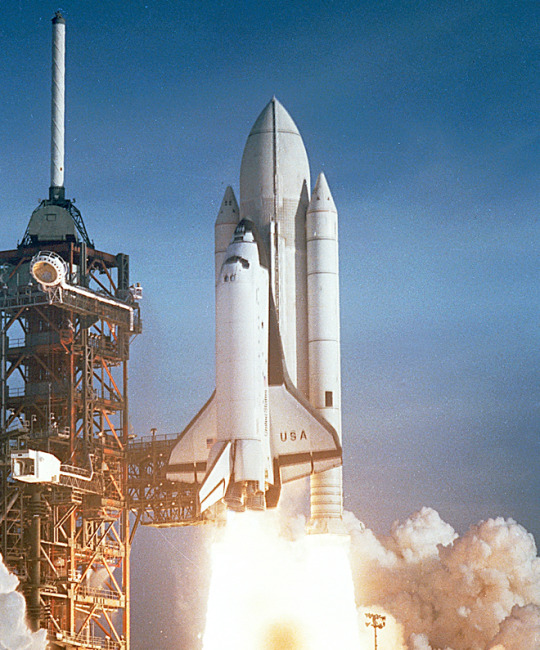
The Space Shuttle Orbiter Columbia lifts off at the start of STS-1.
The first Shuttle flight, designated STS-1, did not in fact lift off until April 12, 1981. As in the STS Flight Assignment Baseline document, OV-102 Columbia performed the OFT missions; OFT concluded, however, after only four flights. After the seven-day STS-4 mission (June 27 - July 4, 1982), President Ronald Reagan declared the Shuttle operational.
The first operational flight, also using Columbia, was STS-5 (November 11-16, 1982). The mission launched SBS-3 and Anik-C/3; because of Shuttle delays, the other SBS and Anik-C satellites planned for Shuttle launch had already reached space atop expendable rockets.
To the chagrin of many Star Trek fans, Enterprise never reached space. NASA decided that it would be less costly to convert Structural Test Article-099 into a flight-worthy Orbiter than to refit Enterprise for spaceflight after the ALT series. OV-099, christened Challenger, first reached space on mission STS-6 (April 4-9, 1983), which saw deployment of the first TDRS satellite.
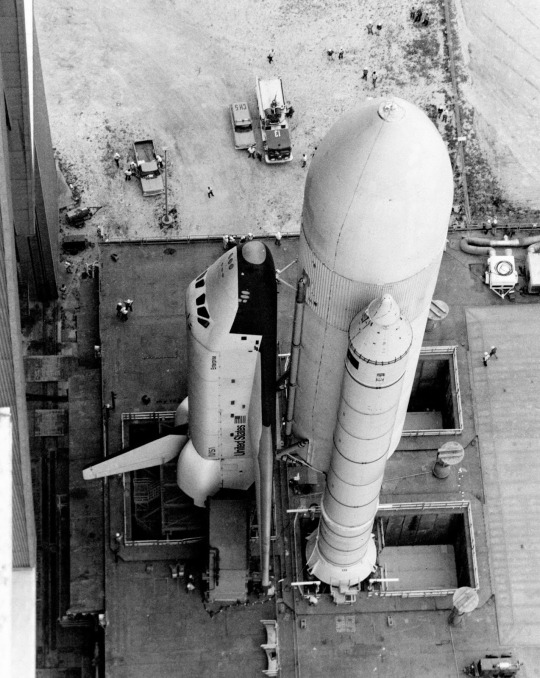
NASA put OV-101 Enterprise to work in a variety of tests and rehearsals (such as the 'fit check' shown in the image above), but did not convert it into a spaceflight-worthy Orbiter.
The voluminous Spacelab pressurized module first reached orbit on board Columbia on mission STS-9 (November 28- December 8,1983). The 10-day Spacelab 1 mission included ESA researcher Ulf Merbold and NASA scientist-astronauts Owen Garriott and Robert Parker. Garriott, selected to be an astronaut in 1965, had flown for 59 days on board the Skylab space station in 1973. Parker had been selected in 1967, but STS-9 was his first spaceflight.
The 21,500-pound LDEF reached Earth orbit on board Challenger on STS-41C, the 11th Space Shuttle mission (April 6-13, 1984). During the same mission, astronauts captured, repaired, and released the SMM satellite, which had reached orbit on 14 February 1980 and malfunctioned in January 1981. Challenger reached SMM without an OMS kit; in fact, no OMS kit ever reached space.
STS Flight Assignment Baseline document assumed that 22 Shuttle flights (six OFT and 16 operational) would occur before January 1982. In fact, the 22nd Shuttle flight did not begin until October 1985, when Challenger carried eight astronauts and the West German Spacelab D1 into space (STS-61A, October 30 - November 6, 1985). Three months later (28 January 1986), Challenger was destroyed at the start of STS-51L, the Shuttle Program's 25th mission.
In addition to seven astronauts — NASA's first in-flight fatalities — Challenger took with it TDRS-B, NASA's second TDRS satellite. The Shuttle would not fly again until September 1988 (STS-26, September 29 - October 3, 1988). On that mission, OV-103 Discovery deployed TDRS-C. The TDRS system would not include the three satellites necessary for global coverage until TDRS-D reached orbit on board Discovery on mission STS-29 (13-18 March 1989).
Following the Challenger accident, NASA abandoned — though not without some resistance — the pretense that it operated a fleet of cargo planes. The space agency had at one time aimed for 60 Shuttle flights per year; between 1988 and 2003, the Shuttle Program managed about six per year. The most flights the Shuttle fleet accomplished in a year was nine in 1985.
Shuttle delays meant that JOP, renamed Galileo, missed its early January 1982 launch window. It was eventually rescheduled for May 1986, but the Challenger accident intervened. Galileo finally left Earth orbit on 18 October 1989 following deployment from OV-104 Atlantis during STS-34 (October 18-23, 1989).
Between the time JOP/Galileo received its first funding and the Challenger explosion, NASA, the White House, and Congress had sparred over how the Jupiter spacecraft would depart Earth orbit. Eventually, they settled on the powerful liquid-propellant Centaur-G' rocket stage.
Citing new concern for safety following Challenger, NASA canceled Centaur G'. Galileo had to rely on the less-powerful IUS, which meant that it could not travel directly to Jupiter; it had instead to perform gravity-assist flybys of Venus and Earth to reach its exploration target. Galileo did not reach the Jupiter system until December 1995.
LDEF had been scheduled for retrieval in March 1985, less than a year after deployment, but flight delays and the Challenger accident postponed its return to Earth by nearly six years. On mission STS-32 (January 9-20, 1990), astronauts on board Columbia retrieved LDEF, the orbit of which had decayed to 178 n mi. LDEF remains the largest object ever retrieved in space and returned to Earth.
During reentry at the end of mission STS-107 (16 January-1 February 2003), Columbia broke apart over northeast Texas, killing its international crew of seven astronauts. This precipitated cancellation of the Space Shuttle Program by President George W. Bush, who announced his decision on 14 January 2004.
The end of the Space Shuttle Program was originally scheduled for 2010, immediately following the planned completion of the International Space Station. In the event, STS-135, the final Space Shuttle mission, took place four years ago (July 2011), three months after the 30th anniversary of STS-1. The Orbiter Atlantis lifted off on 8 July with a four-person crew — the smallest since STS-6. It docked with the International Space Station to deliver supplies and spares and landed in Florida 13 days later."
Article by David S. F. Portree: link
source, source
NASA ID: S77-5784, S77-5785, S77-5758
#STS-1#STS-2#STS-3#STS-4#STS-5#STS-6#STS-7#STS-8#STS-9#STS-10#STS-11#STS-12#STS-13#STS-14#STS-15#STS-16#STS-17#STS-18#STS-19#STS-20#STS-21#STS-22#STS-23#Space Shuttle Columbia#Columbia#OV-102#Space Shuttle Enterprise#Enterprise#OV-101#cancelled
29 notes
·
View notes
Text
The Journey to Break Free • An Analysis of Malevolent's Themes
This is more like a ramble, but analysis sounds more professional y'know y'know-
Major Spoiler Warning for Episode 19
-
Episode 19 may be my favourite episode at least for Season 2 – bear in mind that as I type this, I haven't gone past Episode 19. Regardless, it is definitely a highlight of this podcast for me. It unpacked a lot about Arthur and John, and it explored many interesting themes. The strength of kindess and letting yourself be vulnerable, the reality that healing and becoming a better person isn't always a clean journey, the significance of the connections we make and the memories we carry from them...
The first one is subversive in how despite Arthur losing some of his morality in order to survive, he still retains some of it and uses it ro his advantage. It may be baffling to see Arthur still wanting to trust others and treat them kindly, as seen with Arthur wanting to offer water to the cana, because this world can turn on you so quickly. However, that may be the point. The fact that Arthur can still find it in himself to care about the beings in this world is a true testament to his resilience. The Dreamlands is unrelentlessly cruel and tests you, trying to mold you to become the monsters that roam this realm, and I think that is why Arthur won't succumb to this world's terrors like so many before him did.
It ties into the tone of the podcast and how it shifts. Arthur may need to be cruel at times, but that doesn't mean he needs to be a monster. Likewise, Malevolent may be a bleak story, but it is not one which needs to overly indulges in tragedy and darkness. Even within the episode itself, there are moments where Arthur and John laugh. There's an entire section in which Arthur interacts with a buopoth, and it's the most adorable thing ever. These moments provide a balance that help emphasize the impact of intense moments even more than if the entire story had just been trudged in grimdark.
(Putting the rest under a "Read More" section as to not make this post too long to scroll through)
As for the second theme, I particularly appreciate it as people who try to heal, typically victims of trauma, are often villanized for not being perfect, nice or behaving. Anyone who doesn't fit the mold of being sad and helpless via lashing out or express anger about their trauma get dogpiled with insults and accusations from those who refuse to understand them. Those who only want to imagine a narrative that recovery is always pretty and always going up with no relapses whatsoever. That narrative formed because society crafted it and enforced it with media tackling trauma victims in a shallow way at best. Because it's uncomfortable for society to face the truth that trauma is ugly, and those that went through it won't come out unscathed like people want them to.
The theme of names being significant is an uncommon but meaningful one. John Doe is a name to give the King in Yellow a new identity, a way to rebuild himself. Lilly is a name that meant a lot to John as the only form of human connection he had while Arthur was comatose and the catalyst to John becoming a better person. Faroe is a name that Arthur keeps recalling because he can't let go of his daughter and the trauma that came with it.
Even the name of the episode is important. I think "the Prison" truly is an apt title for this episode. Not only because this involves Arthur and John escaping the pit they're trapped it, but it's also a metaphor for Arthur's situation. His body is a prison for John that both want him to get out of, yet Arthur is the real prisoner as he loses control over everything from his body to his life. He is trapped in the past because he can never let go of Fareo. He can never forgive himself for causing her death through his neglect no matter how unintentional it was.
And he gave in at the end. He gave in to the past and went to the city to search for Faroe even though the cana instructed them to avoid the city. Even though so many signs point to it being yet another trap. Even though the chances of Fareo being there were next to none.
Yet John didn't protest. It really shows how much John has grown to emphathize with humanity. How he has grown from someone who is selfish and uses others to his whims, discarding them when they no longer serve him purpose to someone who may not fully understand humanity but can genuinely appreciate and care about it. He may not understand why Arthur still clings onto Faroe, but he understands Arthur deserves closure, so even if this may be a trap, he lets him walk in. We, the audience, may not fully understand either, but we understand this is a necessary step for Arthur even if it may be one that leads to his doom.
#Overall 10/10 episode!!! I love it#Now if you'll excuse me I'm gonna take a thousand year long nap#It's almost 4 AM but screw it I needed to get this out#I have so much more to say about Episode 19#but I need SLEEP and it will take FOREVER and I have THINGS TO DO EOUGH.#But yeah I love love love this and I love Malevolent#What an outstanding podcast I love it#malevolent#malevolent podcast#malevolent spoilers#arthur lester#john doe malevolent#analysis#media analysis#character analysis#commentary#chris p fried rambles
21 notes
·
View notes